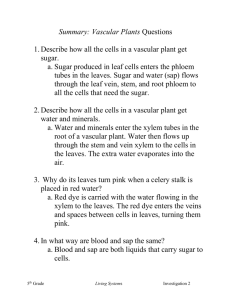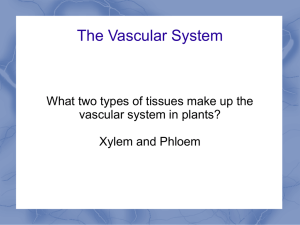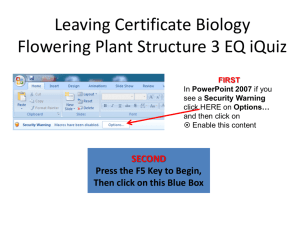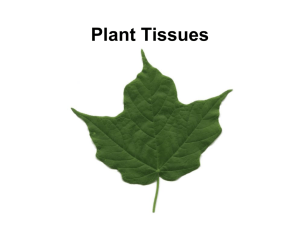Document
advertisement
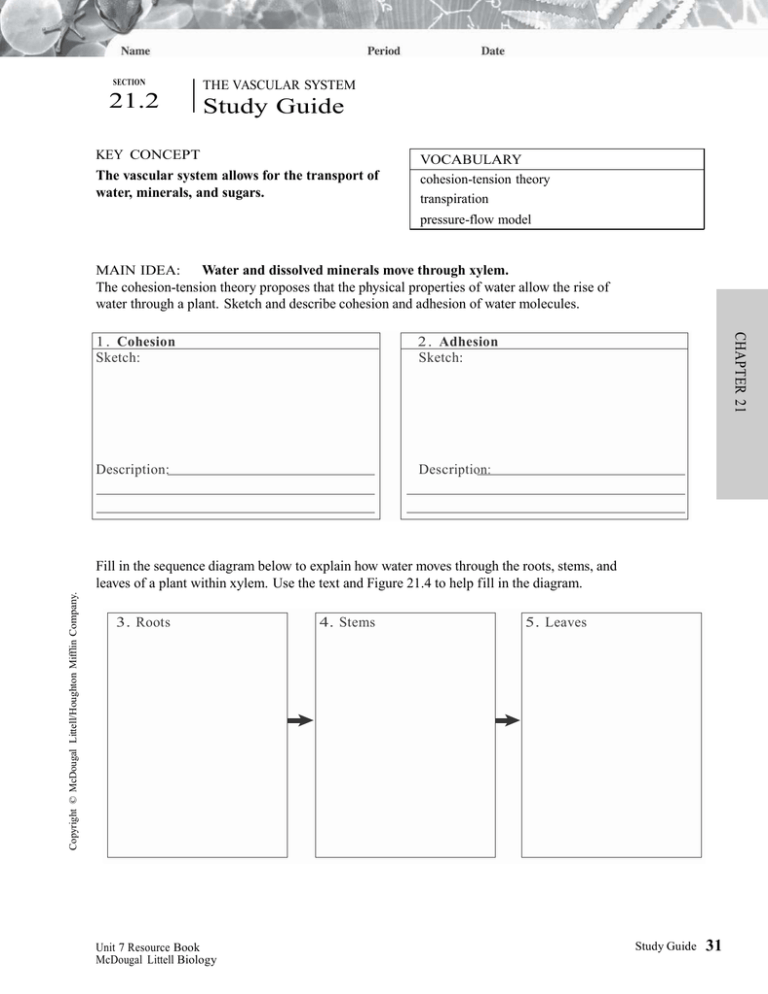
SECTION 21.2 THE VASCULAR SYSTEM Study Guide KEY CONCEPT The vascular system allows for the transport of water, minerals, and sugars. VOCABULARY cohesion-tension theory transpiration pressure-flow model MAIN IDEA: Water and dissolved minerals move through xylem. The cohesion-tension theory proposes that the physical properties of water allow the rise of water through a plant. Sketch and describe cohesion and adhesion of water molecules. Description: Description: Copyright © McDougal Littell/Houghton Mifflin Company. Fill in the sequence diagram below to explain how water moves through the roots, stems, and leaves of a plant within xylem. Use the text and Figure 21.4 to help fill in the diagram. 3. Roots Unit 7 Resource Book McDougal Littell Biology 4. Stems 5. Leaves Study Guide 31 CHAPTER 21 2 . Adhesion Sketch: Plant Structure and Function 1 . Cohesion Sketch: STUDY GUIDE, CONTINUED MAIN IDEA: Phloem carries sugars from photosynthesis throughout the plant. 6. Phloem sap moves from a sugar source to a sugar sink. What are two plant parts that might be sources of sugars? 7. What is a sugar sink in a plant? 8. The pressure changes between sugar sources and sinks keeps sap flowing through phloem. Is there a higher concentration of sugars at a sugar source or a sugar sink? 9. In the movement of sap through phloem, what two events require energy on the part of the plant? 10. Water moves into the phloem due to the high sugar concentration there. It requires no energy. What is this process called? Vocabulary Check pressure-flow model transpiration 11. Well-supported theory that describes how sugars move through a plant within phloem 12. Well-supported theory that describes how water and dissolved minerals move through a plant within xylem 13. Term that describes how water moves through a plant within xylem by evaporation from leaves 32 Study Guide Unit 7 Resource Book McDougal Littell Biology Copyright © McDougal Littell/Houghton Mifflin Company. cohesion-tension theory SECTION 21.2 THE VASCULAR SYSTEM Reinforcement KEY CONCEPT The vascular system allows for the transport of water, minerals, and sugars. Xylem and phloem are the two main tissues of the vascular system. Water and dissolved minerals move from the roots to the rest of the plant through xylem. Plants don’t use any energy to move water through xylem. Instead, the cohesion-tension theory proposes that the physical properties of water allow the rise of fluids through a plant. • The tendency of hydrogen bonds to form between water molecules creates a force called cohesion. Plant Structure and Function • The attraction of the water molecules to the xylem walls is due to adhesion, a force made by • Cohesion and adhesion create tension that moves water upward in xylem. Although the forces of cohesion and adhesion can keep a water column together inside of a plant, they are not the main force moving water upward through a plant. Upward force is also provided by the evaporation of water from leaves. This loss of water vapor from plants is called transpiration. As leaves transpire, the outward flow of water lowers the pressure in the leaf xylem, creating a vacuum that pulls water upward. The second tissue in a plant’s vascular system is phloem tissue. Phloem carries plant nutrients, including minerals and sugars, throughout the plant. Phloem moves the products of photosynthesis out of the leaves to stems and roots. While fluids in xylem always flow away from the roots toward the rest of the plant, phloem fluids—or sap—can move in any direction, depending on the plant’s need. The pressure-flow model explains how sugars from photosynthesis move through the plant within the phloem. Phloem sap moves from a sugar source to a sugar sink. A source is any part of the plant that has a high concentration of sugars. Most commonly this source is the leaves, but it can also be where sugars have been stored, such as the roots. A sink is the part of the plant using or storing the sugar, such as growing stems, a fruit, or even the storage roots that will be a sugar source later in the season. The locations of sugar sources and sinks in a plant can change as the plant grows and as the seasons change. 1. Xylem and phloem are both plant vascular tissues. How are the functions of xylem and phloem different? 2. What is the main process moving water upward through plants? 3. Why are leaves the most common source for sugars in a plant? 34 Reinforcement Unit 7 Resource Book McDougal Littell Biology Copyright © McDougal Littell/Houghton Mifflin Company. CHAPTER 21 hydrogen bonds forming between water molecules and other substances.
